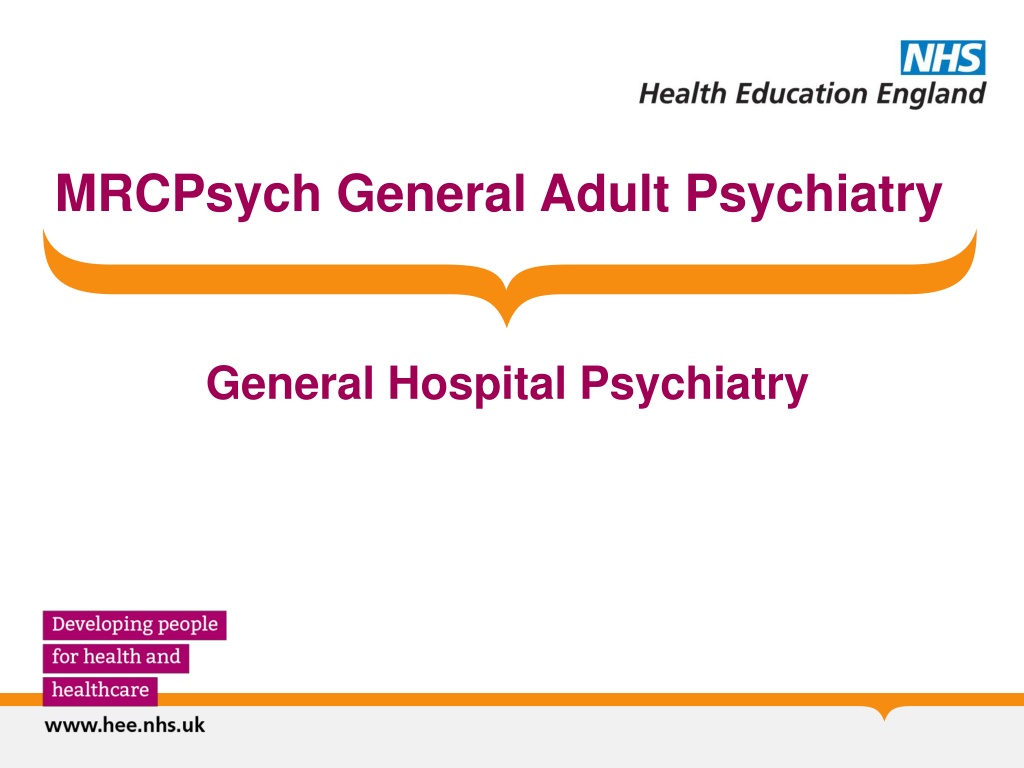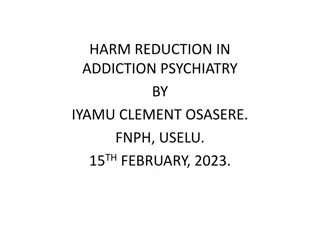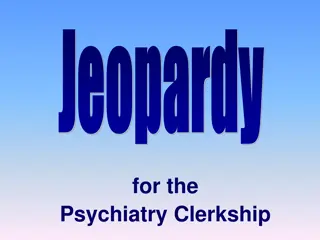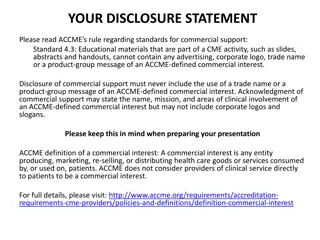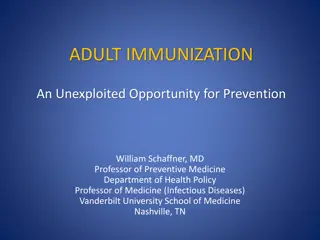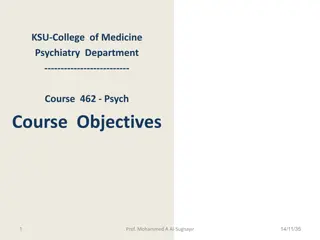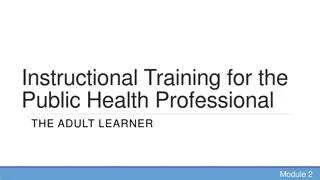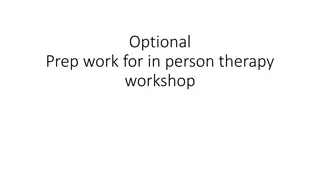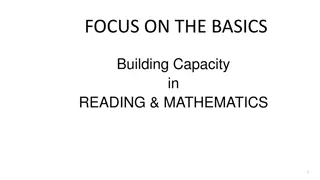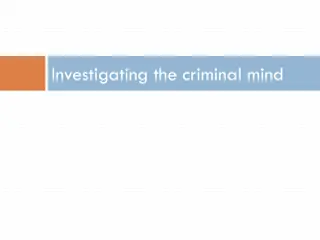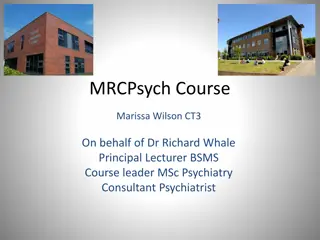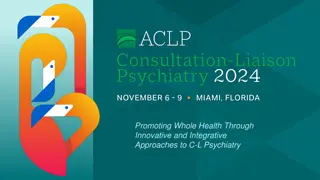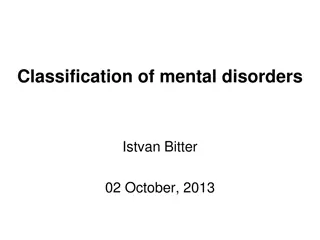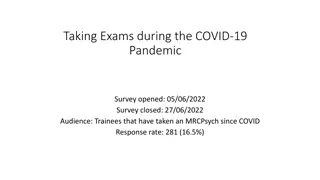MRCPsych General Adult Psychiatry
Develop an understanding of psychiatric assessment in physical illness, brain pathology, chronic fatigue, and pain management. Explore case examples and communication strategies in challenging situations within a general hospital setting.
Download Presentation

Please find below an Image/Link to download the presentation.
The content on the website is provided AS IS for your information and personal use only. It may not be sold, licensed, or shared on other websites without obtaining consent from the author.If you encounter any issues during the download, it is possible that the publisher has removed the file from their server.
You are allowed to download the files provided on this website for personal or commercial use, subject to the condition that they are used lawfully. All files are the property of their respective owners.
The content on the website is provided AS IS for your information and personal use only. It may not be sold, licensed, or shared on other websites without obtaining consent from the author.
E N D
Presentation Transcript
MRCPsych General Adult Psychiatry General Hospital Psychiatry
General Hospital Psychiatry Objectives To develop an understanding of: psychiatric assessment of patients with physical illness, liaising with colleagues in other specialties, psychiatric consequences and aspects of brain pathology; and clinical and theoretical psychiatric aspects of chronic fatigue and pain, including management.
General Hospital Psychiatry Expert Led Session General Hospital Psychiatry
This lecture complements material covered during the liaison psychiatry academic day: Assessment of sequelae associated with diseases of brain and body- a case example Somatoform pain disorders Chronic fatigue and Fibromyalgia
Objectives for Case Review collateral history taking framework for patients with catastrophic injuries in a general hospital setting Discuss communication strategies in challenging situations Outline an example of reading around a case to separate primary neurological from psychiatric diagnoses The patient as teacher 4 clinical pearls
Case James is 62. He was admitted after having a pontine stroke. He is quadriparetic, has a tracheostomy in situ and is currently fed via NG tube. Nursing staff are concerned he is depressed. What collateral history do you want to obtain from staff and relatives questions? Discuss in small groups
Collateral from nursing staff, allied healthcare practitioners and relatives: What triggered concerns - acute or cumulative changes? Levels of lucidity, engagement, co-operation with care interventions, communication strategies, visible enjoyment when receiving visits? Concerns regarding pain, pressure areas, nutrition and fluid balance, constipation, sleep-wake cycle
Collateral from nursing staff, allied healthcare practitioners and relatives: History of mental health problems? Premorbid personality, coping style, cognitive status, functional ability, major pastimes and pleasures (potential losses, role changes but also what can still be enjoyed) Any recent or ongoing stressors at home / work? Social circumstances and support mechanisms at home How are partner and family coping?
Collateral from medical colleagues Extent of injury Prognosis mobility, airway and feeding Acute, superimposed concerns (physical observations, infection, electrolyte imbalance, renal failure etc think DELIRIUM) Ongoing concerns - past medical history Current medications Management plan
Assessment James is alert and it is apparent he has a good range of eye movement as you enter the room. You introduce yourself and explain the purpose of the assessment What strategies might you use to ascertain his level of orientation, and what types of questions are you going to ask about his mood? Discuss in small groups
Communicating - bridging the gap There are no right answers here. Explore what is easiest for the patient. It might not be immediately obvious. Head movements for yes/no or gently squeezing your hand, tapping a hand on the bed, eye movements could be used but would be further down the list in terms of simplicity Writing is also an option for patients with focal oro-laryngeal problems (post op etc) James is quadriparetic, not quadriplegic. He was able to use his right hand to communicate by squeezing the interviewers hand
Treatment and follow up James finds himself crying for no apparent reason. He is devastated about the stroke, but does enjoy visits from his family. Sleep is poor. He cannot think about the future but is clear he has not had any thoughts of ending his life. A major preoccupation is shoulder pain. Plan Physio input and analgesia. Mirtazepine and/or pause while further reading occurs?
Read around your patients Brainstem compression from a trigeminal schwannoma presenting with pathological crying. J Clin Neurosci. 2008 Mar;15(3):322-4 Neuroimaging of serotonin transporters in post-stroke pathological crying. Psychiatry Res. 2003 Jul 30;123(3):207-11. Serotonin 5HT1A receptor availability and pathological crying after stroke. Acta Neurol Scand. 2007 Aug;116(2):83-90. Involuntary motor phenomena in the locked-in syndrome. J Neurol. 1980;223(3):191-8. Pathological crying as a manifestation of spontaneous haemorrhage in a pontine cavernous haemangioma. J Clin Neurosci. 2010 May;17(5):662-3 We diagnosed pathological crying secondary to the pontine lesion and kept the Mirtazepine to boost serotonin and aid sleep. He responded well.
Stroke Exam notes Comorbid depression in 35% patients Comorbid anxiety in 25 % patients (cortical infarcts) Apathy, catastrophic reactions and undue lability (esp frontal CVA) in 20% patients Delirium occurs in up to a third of patients experiencing haemorrhagic CVA (can respond to small doses of haloperidol) Mania and psychoses are rare Left sided basal ganglia infarcts have been associated with increased risk of post CVA depression SSRI s first line for mood, anxiety, lability
Outcome & Summary James was able to use a speaking tube 6 weeks after we met him. He gave me these teaching points for this session: Don t be scared to ask difficult questions Take the time to find a way to communicate properly Don t underestimate the effect of pain on mood and outlook on life. Its not always where you expect to find it. Keep coming even when you think there s nothing much more to do. Explaining the crying to me and the wife was a big relief.
Further Themes in GHP Somatoform pain disorders Chronic fatigue Fibromyalgia Huge topics all will require further reading for the interested
Somatoform Pain Disorders Pain in one or more anatomical sites pain is the predominant focus of presentation and severe enough to request a clinical opinion Pain causes significant distress or impairment in social, occupational or other important areas of function Psychological factors are thought to contribute to onset, severity, maintenance, exacerbation of pain
Somatoform Pain Disorders Pain is not intentionally produced or feigned (factitious disorder or malingering) Pain is not better accounted for by mood, anxiety or psychotic disorder Note that a co-existing medical condition may be present (common conditions include rheumatoid and osteo arthritis, disc herniation, osteoporosis, neuropathies, metastatic disease)
Somatoform Pain Disorders Acute = less than 6 months Chronic = greater than 6 months Differential diagnosis Organic condition Somatisation Depression Anxiety disorder Psychosis (coenestopathic states) Factitious disorder Malingering
A few organic considerations Fractures,including compression fractures Sprains and strains, Tendinitis Rheumatoid and osteoarthritis Polymyalgia rheumatica, Polymyositis Herniae causing compression (obturator, sciatic, inguinal , femoral etc) Disc herniation Radiculopathy / neuropathy / neuralgias Neoplasia Each organ system has its own pain differential (angina, nephrolithiasis, reflux etc)
Common syndromes Tension headache Temporomandibular pain Atypical facial pain Non cardiac chest pain Non ulcer dyspepsia Irritable bowel syndrome Chronic pelvic pain Irritable bladder syndrome Proctalgia fugax Fibromyalgia
A few facts and figures (Grabe 2003, Katz 2015) Lifetime prevalence of chronic pain syndromes 12.3% Female: male ratio: 2:1 Odds ratio for comorbid depression : 2.5 Odds ratio for comorbid anxiety disorder : 2.3
Associated Features Search for precipitants and maintaining factors (emotional conflict, psychosocial stressors, potential gains from adopting sick role) Comorbid mood and anxiety disorders (may precede, co-occur or result from pain syndrome) Sleep - initial insomnia, fragmentation, reduced sleep time Alcohol and substance misuse, including analgesics Social isolation, reduced activity levels Explore possibility of doctor shopping, over investigation, iatrogenic analgesic dependence
Using a multi-axial system International association for the study of pain propose a five axis system to characterise pain syndromes: I - site II - organ system III - temporal characteristics IV - severity and duration (since onset) V - aetiology
Assessment Framework Quality of pain (affective and sensory dimensions e.g. vicious, exhausting, crushing, burning) Location and distribution Duration and timing of first onset Relapses and remissions Related life events and difficulties Personal and Family history of severe, chronic or disabling physical disorders Adverse childhood experiences Collateral history is often vital (chronicle of distressing events and also attitudes, knowledge and beliefs of carers)
Treating Somatoform Pain Disorders Pharmacological strategies include TCA s, SSRI s, Pregabalin and Gabapentin Psychological therapies centre on CBT and tackle perceived locus of control, attributional style, cognitive distortions and coping strategies Relaxation techniques, physiotherapy, graded exercise therapy and biofeedback (increasing awareness of autonomic changes and stress) are also used
Further Reading Katz J, Rosenbloom BN, Fashler S.(2015). Chronic Pain, Psychopathology, and DSM-5 Somatic Symptom Disorder. Can J Psychiatry. Apr;60(4):160-7. Burke AL1,2, Mathias JL2, Denson LA2. Psychological function of people living with chronic pain. Br J Clin Psychol. 2015 Sep;54(3):345-60
Chronic Fatigue Syndrome A perpetually controversial condition 0.4% European population have it F:M = 4:1 Bimodal age at onset: 13-15 yrs - early 20 s- peaks at mid 40 s (online exam notes age at onset 29-35yrs, M:F 1:3, duration 3-9 years)
Diagnostic Frameworks Not easy to find at first glance. Chronic fatigue is not listed in either ICD-10 or DSM but.. ICD-10 : G93.3 (Benign Myalgic Encephalomyelitis) ICD-10 : F48.0 (Neurasthenia) DSM-IV : Undifferentiated somatic symptom disorder
CDC Consensus Definition New onset fatigue, not relieved by rest and lasting at least 6 months 4 of subjective memory impairment, sore throat, tender lymph nodes, muscle and joint pain, unrefreshing sleep, post exertional malaise lasting >24h Impaired functioning Other conditions that may explain fatigue have been excluded
ICD-10 Persistent and distressing complaints of increased bodily fatigue after mental effort, or persistent and distressing complaints of bodily weakness and exhaustion after minimal effort 2 or more of : muscle aches and pains, dizziness, tension headaches, sleep disturbance, inability to relax, irritability, dyspepsia Any autonomic or depressive symptoms are not persistent and severe enough to fulfil criteria for another diagnosis Post viral G93.3, cause unknown F48!..
DSM One or more physical complaints Investigations have not revealed a medical or substance related cause OR Where there is a medical condition, the physical complaints and related impairment is in excess of what would be expected from history, examination and investigations Clinically significant distress or functional impairment Duration at least 6 months Not intentionally produced or feigned Not better accounted for by another mental disorder
Controversy Patients present with persistent relapses of fatigue, musculoskeletal pain, sluggish mentation and memory difficulties, disturbed sleep-wake cycle which collectively impair functioning. Precipitant infection or other environmental trigger causes fatigue in predisposed individuals. Perpetuators are psychiatric symptoms primary, secondary or occurring in parallel with underlying physiological, immunological or inflammatory causes?
Psychologically based Treatments Exercise therapy for chronic fatigue syndrome. Cochrane Database Syst Rev. 2015 Feb 10;2 General benefits from CBT and GET (Graded Exercise Therapy) Positive effects - sleep, physical function and self-perceived general health Equivocal for the outcomes of pain, quality of life, anxiety, depression, drop-out rate and health service resources
Biology & Pharmacotherapy Markers of altered NK, B and T cell function, raised cytokine levels, reduced ATP levels have been found in CFS/ME patients Results using Galantamine and hydrocortisone have been published but outcomes are poor (J R Soc Med. 2006 Oct; 99(10): 506 520) Clinical impact of B-cell depletion with the anti-CD20 antibody rituximab in chronic fatigue syndrome: a preliminary case series. BMC Neurol. 2009 Jul 1;9:28. N=3 study with positive results.
Summary Reasonable consensus on possibility of a biological trigger such as a viral infection, (though some argue psychological stressors could also act as triggers) Huge controversy regarding maintaining factors (Inflammatory mediators, Endocrine changes, Psychological mechanisms or possibly a combination) The only treatments so far with a reasonable evidence base are CBT and GET How far should efforts go with immunosuppressive therapy? (Steroids, methotrexate, monoclonal antibodies, plasma exchange?..)
Fibromyalgia Chronic pain disorder Prevalence of 2-3% worldwide Second most common disorder in rheumatology clinics F:M = 7:1 x8 increase in risk in first degree relatives Thought to arise from central amplification of pain perception
Diagnosis ACR criteria - Sensitivity 88.4, Specificity 81.1% 3 months or more of: Widespread pain including axial regions Tenderness in 18 or more designated palpation points Fatigue and sleep disturbance are also common and form a core triad with pain
Mood and anxiety disorders are highly comorbid (up to 75%) Regional pain syndromes also highly comorbid IBS, headache, pelvic pain
Differential Culprit medications Statin related pain or opioid induced hyperalgesia? Hypothyroidism Inflammatory rheumatic diseases (RA, polymyalgia rheumatica, SLE, polymyositis) Osteoarthritis Neuropathies
Amitryptyline starting at 10mg nocte Duloxetine starting at 30mg daily Milnacipran starting at 50mg mane Pregabalin starting at 50-100mg nocte Mostly unlicensed treatments but some efficacy demonstrated across studies
General Hospital Psychiatry MCQs 1. Lesions in the following structure have been associated with pathological crying: A. Temporal pole B. Pineal gland C. Caudate nucleus D. Pons E. Tegmentum
General Hospital Psychiatry MCQs 1. Lesions in the following structure have been associated with pathological crying: A. Temporal pole B. Pineal gland C. Caudate nucleus D. Pons E. Tegmentum
General Hospital Psychiatry MCQs 2. The following theoretical model is commonly applied to somatoform pain disorders: A. Central demyelination theory B. Central sensitisation theory C. Operant sensitisation theory D. Central operant theory E. Operant receptive field theory
General Hospital Psychiatry MCQs 2. The following theoretical model is commonly applied to somatoform pain disorders: A. Central demyelination theory B. Central sensitisation theory C. Operant sensitisation theory D. Central operant theory E. Operant receptive field theory
General Hospital Psychiatry MCQs 3. Diagnostic criteria for Chronic fatigue syndrome requires a duration of symptoms for at least A. 4 weeks B. 3 months C. 4 months D. 6 months E. 12 months
General Hospital Psychiatry MCQs 3. Diagnostic criteria for Chronic fatigue syndrome requires a duration of symptoms for at least A. 4 weeks B. 3 months C. 4 months D. 6 months E. 12 months
General Hospital Psychiatry MCQs 4. Diagnostic criteria for Fibromyalgia requires a duration of symptoms for at least A. 4 weeks B. 3 months C. 4 months D. 6 months E. 12 months
